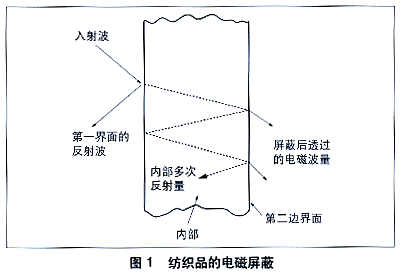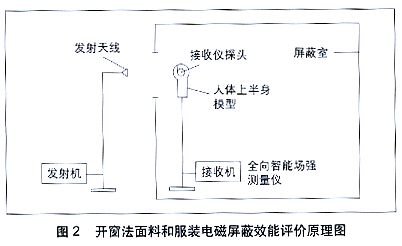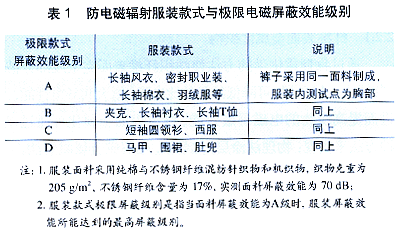

Hotline:0755-22277778
Tel:0755-22277778
Mobile:13826586185(Mr.Duan)
Fax:0755-22277776
E-mail:duanlian@xianjinyuan.cn
Electromagnetic radiation is the fourth largest source of pollution after air, water, and noise pollution. Due to living in an intangible electromagnetic radiation network, the living environment is generally safe. However, in certain special situations, when the intensity of electromagnetic radiation reaches its limit, it may pose a threat to the human body without people's knowledge.
In order to reduce or eliminate the harm caused by electromagnetic radiation to the human body, developed countries have been conducting research on special protective clothing and fabrics since the 1930s and 1940s. In the 1980s, the United States developed protective clothing that utilized metal mesh or metal materials to reflect and absorb electromagnetic waves for shielding purposes; Japan and other countries have researched and developed shielding fabrics made from a blend of stainless steel fiber and fabric fibers, which are used to make shielding clothing for microwave protection, such as radar protection. In the late 1980s to early 1990s, in order to prevent the radiation hazards of household appliances, especially the impact on women and children, developed countries sparked a trend of "pregnant women" wearing shielding aprons, shielding coats, teenagers wearing shielding vests, and shielding suits. Anti electromagnetic radiation clothing entered households and expanded to the civilian clothing market. In the mid-1990s, Japan was the first to successfully develop metalized fibers. In the late 1990s, the United States was the first to develop a polyester plain weave metalized fabric with a metal coating on the outer layer of fibers, which can effectively improve the electronic monitoring and protection capabilities of military bases.
China began researching electromagnetic radiation and protective clothing in the 1960s, and officially produced blended fabrics made of copper wire and oak silk in the 1970s and 1980sShielded clothingAnd microwave absorbing protective clothing. Afterwards, stainless steel softened fiber shielding fabrics, special process coated shielding fabrics, and clothing also emerged one after another, but it was not until the mid-1990s that they truly entered the civilian market. Since the 1990s, with the development and application of multifunctional protective clothing, as well as an increase in news media reports on the impact of electromagnetic waves on the human body, people's self-protection awareness has strengthened, and radiation resistant clothing has begun to move towards civilian use and be favored by consumers.
Due to the varying degrees of harm caused by electromagnetic radiation to various organs of the human body, people have designed various styles of anti electromagnetic radiation clothing to reduce its harm, which can be classified from two aspects: wearability and fabric manufacturing principles.
2.1 Classification by Medication Performance
According to their performance, they can be divided into radiation resistant workwear, radiation resistant men's clothing, radiation resistant camisoles, radiation resistant maternity clothing, radiation resistant children's clothing, radiation resistant vests, radiation resistant bellybands, radiation resistant aprons, radiation resistant underwear, radiation resistant accessories (radiation resistant necklaces, collars, pendants, etc.), radiation resistant combinations, etc.
Anti radiation workwear is mainly used for workers engaged in high-power transmitter, equipment, and instrument operations, requiring good anti radiation effects and the ability to shield a large amount of high-frequency microwave radiation; Radiation resistant maternity and children's clothing are mainly used to protect pregnant women and infants. The long-term effects of electromagnetic radiation can cause genetic mutations in unborn fetuses, leaving behind difficult to cure congenital diseases; Anti radiation vests, bellyballs, and aprons are mainly used to shield against electromagnetic waves leaked from daily life, household appliances, computers, mobile phones, etc. in the office, and are mainly targeted for the protection of organs such as the heart and chest. Anti radiation combination refers to the systematic and purposeful combination of various styles of anti electromagnetic radiation clothing, accessories, etc., to achieve a perfect combination of anti radiation function and beautiful and comfortable wearing effect.
2.2 Classification by Fabric Production Principle
According to the production principle of shielding fabrics, they can be divided into two categories: fiber surface metallization and metal doped fabrics, both of which use metal media to improve the electromagnetic shielding performance of the fabric.
2.2.1 Fiber surface metalized fabric
By using physical or chemical methods to completely or partially "coat" the surface of textile fibers with a layer of metal, the specific resistance of the fibers can be reduced, their conductivity can be increased, and thus the electromagnetic shielding effectiveness of the fabric can be improved. Fiber surface metallization can be achieved through three methods: physical coating, chemical coating, electrolysis, or metal sputtering.
Physical coating: A coating agent containing conductive materials (such as certain metals, their salts, and carbon black) is used to coat the surface of the fabric, forming a thin metal film on the fabric surface. Due to the high density of metal ions on the film, the electromagnetic shielding effect of the coated fabric is relatively high, generally around 20dB. However, the bonding force between the metal coating and the fabric is relatively small, so the processability, washing resistance, and corrosion resistance of the fabric are poor. Once the metal film falls off locally, the shielding effectiveness of the fabric will be greatly reduced.
Chemical method: Using chemical methods to cause chemical reactions between metal ions and some functional groups of textile fibers, the metal ions are tightly "bound" to the textile fibers, achieving the metallization of the fibers. The matrix fibers used by chemical methods are generally acrylic or modified acrylic. The cyanide group (- CN) on acrylic is coordinated with metal ions (such as copper ions) to form complexes, which then generate conductive substances on the fibers, making them conductive. The fibers are then woven into shielding fabrics through textile processes, which have good electromagnetic shielding effectiveness. Shielding fabrics made by chemical methods can maintain the performance, color, and feel of ordinary fabrics, and have excellent electromagnetic shielding effectiveness, with huge development prospects.
Electrolysis or metal sputtering method: This method uses a strong magnetic field to form an ion cloud around the metal, making the metal itself in a negative valence state, attracting positive ions, and allowing metal atoms to gain energy and be ejected, depositing on adjacent coated objects to form sprayed metal. This processing method has a slow speed and high cost, but the metal coating is uniform, the adhesion is strong, the corrosion resistance is high, the working frequency is wide, and the shielding performance is good, so it is widely used in various fields.
2.2.2 Metal doping into fabrics
Mixing metal fibers or wires into fabrics is one of the simplest and most flexible methods for preparing electromagnetic radiation resistant clothing. It can be divided into two types: blending metal fibers with ordinary fibers and wrapping or weaving metal wires with ordinary yarns.
Metal fiber blend: Metal blended conductive fabric refers to a fabric formed by blending and interweaving natural fibers such as cotton, linen, silk, and wool with stainless steel short fibers, ceramic fibers, nickel fibers, carbon fibers, etc. through special processes to prevent electromagnetic radiation. This type of fabric has a soft hand feel, multiple dyeing patterns, good breathability, lightweight and comfortable, relatively washable, and long service life. Moreover, the shielding effectiveness of the clothing is independent of environmental temperature and humidity, and the protective effect is reliable; But the shielding efficiency is relatively low, generally the electromagnetic energy attenuation (shielding effectiveness) is around 15-30dB. Although metal fibers are flexible and similar to textile fibers, they have a high surface friction coefficient, high specific gravity, poor bending stiffness, poor elastic recovery rate, low gripping force, poor spinnability, and poor moisture absorption and dyeing ability, which affect the style of the fabric.
Wrapping and mixing metal wire and ordinary yarn: This is an early method of manufacturing electromagnetic radiation resistant clothing, and it has good shielding effect. The fabric is wear-resistant and washable, but it is relatively thick, stiff to the touch, and not resistant to folding, resulting in poor wearability.
2.3 Classification of Electromagnetic Radiation Resistant Clothing
The overall shielding effectiveness of the clothing is rated as Grade A with 70dB or above, indicating excellent shielding effect; 30-70dB is B-level and has shielding effect; 15-30dB is classified as level C and has a certain shielding effect; Below 15dB is classified as D-level, and the shielding effect is not significant.
3.1 Electromagnetic shielding principle
Electromagnetic wave propagation reachesElectromagnetic shielding materialOn the surface, there are usually three different attenuation mechanisms: one is the reflection attenuation on the incident surface; The second is the attenuation of electromagnetic waves that enter the shielding body without being reflected and are absorbed by the shielding material; The third is the multiple reflection attenuation inside the shielding body. The total shielding effect of electromagnetic waves passing through shielding materials can be calculated according to the following formula:
In the formula SE=R A B, SE represents the electromagnetic shielding effect; R is the surface single reflection attenuation; A is absorption attenuation; The month represents multiple internal reflection attenuation (only meaningful when A<15dB).
Due to the fact that textiles are generally single-layer or multi-layer block fabrics with a certain thickness, when metal yarns or wires with electromagnetic shielding properties are interwoven with each other on the fabric according to certain rules, electromagnetic waves will undergo single or multiple reflections and attenuation on the surface and inside of the fabric, absorbing and attenuating (Figure 1).

When electromagnetic waves reach the surface of the fabric, due to the effect of the shielding material inside the fabric, a portion of the electromagnetic waves cause the shielding material to generate induced electromotive force, forming induced current I. The shielding material has a certain resistance R, which results in I2R heat loss on the shielding material. As the working time increases, the temperature of the fabric rises, and the fabric absorbs the electromagnetic waves; When another part of the electromagnetic waves are emitted from the air medium onto the surface of the fabric, at the interface between the air and the electromagnetic shielding fabric, the sudden change in wave impedance causes the reflection of the waves, resulting in the reflection effect of the fabric on the electromagnetic waves; Other electromagnetic waves are reflected and absorbed multiple times inside the fabric after passing through the first interface, and eventually some electromagnetic waves pass through the second interface without being shielded and consumed.
The electromagnetic shielding effectiveness of textiles depends on the shielding materials and their content in the fabric, as well as the thickness and tightness of the fabric. For low-frequency electromagnetic waves, the surface reflection of the fabric is the main component, so the better the conductivity and reflection of the shielding material, the better the shielding effectiveness of the fabric; For high-frequency electromagnetic waves, their attenuation mainly depends on the absorption loss of the electromagnetic waves in the shielding material, so fabrics with better magnetic conductivity have better shielding effectiveness.
3.2 Electromagnetic shielding evaluation method
At present, there are two evaluation indicators for the electromagnetic shielding effect of materials both domestically and internationally, namely shielding effectiveness (SE) and attenuation rate. According to the standards of ASTMD4935 (American Society for Testing and Materials) and IEEE-299 (Institute of Electrical and Electronics Engineers), it is assumed that P1 and P2 are the field strength (power density) measured when electromagnetic radiation protective clothing is not loaded and the field strength measured when electromagnetic radiation protective clothing is loaded, respectively. If the unit is μ W/cm2 or mW/cm2, the calculation formula can be expressed as:
Usually, the electromagnetic shielding effectiveness of anti electromagnetic radiation clothing needs to reach 15dB to meet the electromagnetic radiation requirements of ordinary household appliances, such as computers, microwave ovens, etc; After exceeding 60dB, it can basically shield the radiation of mobile phone signals; But for other military textiles with special functions, higher electromagnetic shielding efficiency is required. The evaluation method is shown in Figure 2.

For anti electromagnetic radiation clothing, it is not only necessary to evaluate the shielding effectiveness of the fabric, but more importantly, to evaluate the overall shielding effectiveness of the clothing. Due to the requirement of clothing style to create openings (exposed area), when the shielding effectiveness of the fabric is at an effective constant value, the larger the opening, the worse the overall shielding effectiveness of the clothing.
When the electromagnetic shielding effectiveness of clothing fabrics reaches Class A, fully enclosed clothing can theoretically also reach Class A, but usually due to the presence of openings, the overall shielding effectiveness of clothing will be reduced to Class B or C. The actual test results are shown in Table 1.

The shielding classification of anti electromagnetic radiation clothing should be obtained based on actual measurement results. Usually, the measured level of high-level clothing styles is one level or more lower than the style level, and the level of low-level clothing styles will not increase. This is very important in practice and has practical significance for both clothing manufacturing and consumer purchasing of goods.

Advanced Institute (Shenzhen) Technology Co., Ltd, © two thousand and twenty-onewww.leird.cn. All rights reservedGuangdong ICP No. 2021051947-1 © two thousand and twenty-onewww.xianjinyuan.cn. All rights reservedGuangdong ICP No. 2021051947-2